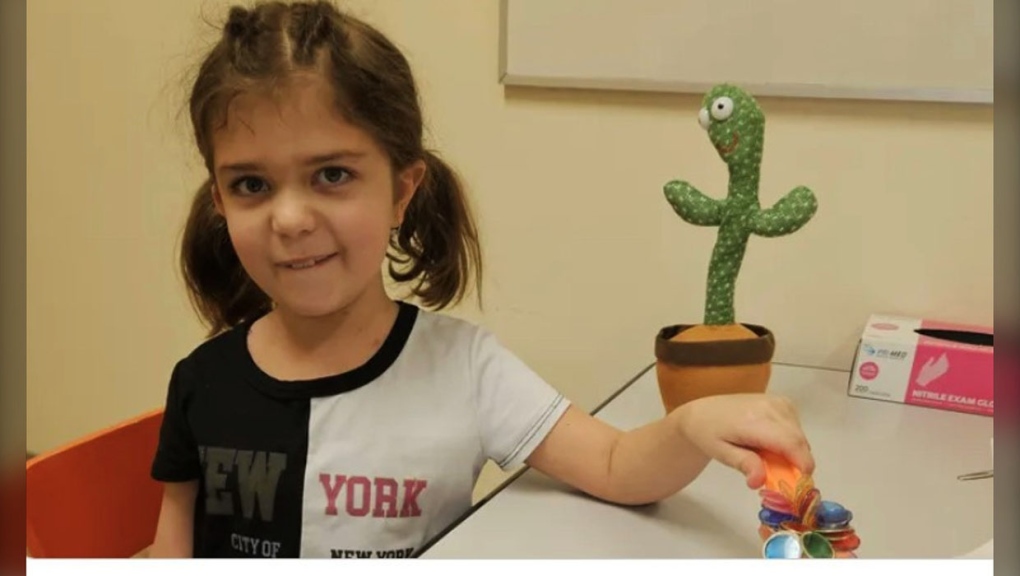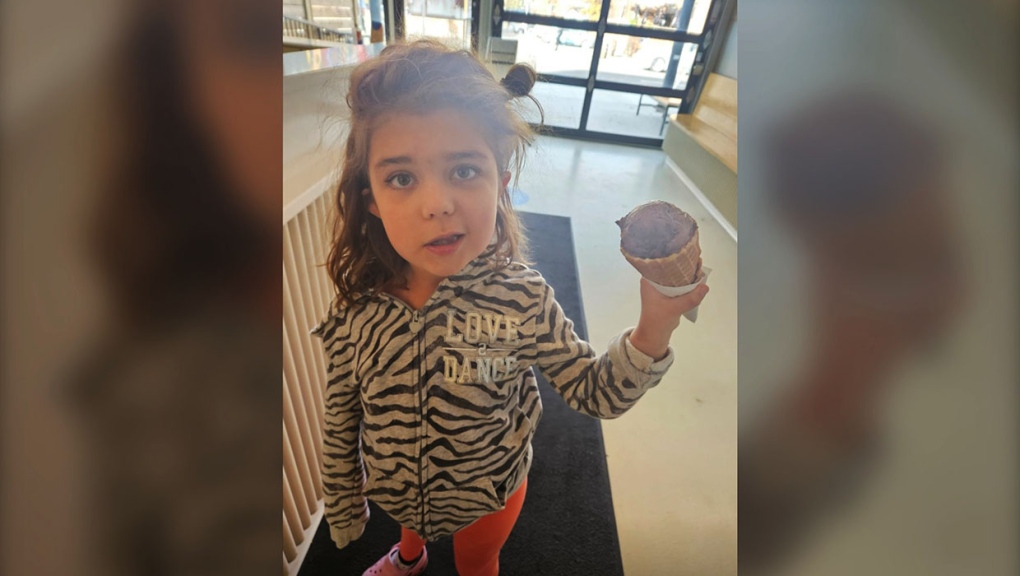Calgary family in desperate need of funds for daughter with rare brain disease
A Calgary family is desperately seeking funds for a major surgery after doctors found an enlarged tumour inside the brain of their eight-year-old daughter.
Olivia Danilenka is described as a happy and especially smart child with excellent learning skills for her age, but she was recently diagnosed in August of last year with a rare and aggressive brain disease called neurofibromatosis type 1 (NF1).
The disease is most commonly inherited through neurological disorders, affecting about one in 3,000 people worldwide. The tumours of this disorder are non-cancerous, but they grow on nerves, impacting both speech and motor skills.
It may cause dark spots to form on the skin that are similar to birthmarks (called café-au-lait spots). NF1 can cause tumours (neurofibromas) on or under the skin, in the eyes, or in the nervous system (brain and spinal cord)
“It all started in July when Olivia was having trouble using her right hand,” said Olivia’s mother, Natallia Danilenka.
“We went to three family doctors, none of them raised concerns and we thought it was just an allergic reaction, but then we were sent for x-rays, a CT scan and then an MRI which showed there was a tumour in her head.”
DIAGNOSED WITH BRAIN TUMOUR
Olivia was diagnosed with a brain tumour in her thalamus section of her brain and despite undergoing chemotherapy, it has since doubled in size.
The slight pain in her arm has now left it completely non-functional, her right leg is progressively weaker and her speech is so slurred that it is often unrecognizable.
 Olivia was diagnosed with a brain tumour in her thalamus section of her brain and despite undergoing chemotherapy, it has since doubled in size.
Olivia was diagnosed with a brain tumour in her thalamus section of her brain and despite undergoing chemotherapy, it has since doubled in size.
“At this point, the only choice we have in Canada is to partially remove the tumour, which might provide temporary relief with only a 30 per cent chance of success," Danilenka said.
"The tumour keeps growing, the symptoms are getting worse, and if we don't remove the entire tumour, there's a high risk it could become life-threatening."
MEMPHIS EXPERT
However, after extensive research, the family has reached out to Dr. Paul Klimo, a highly experienced surgeon from Le Bonheur Children’s Hospital in Memphis, TN., who specialized in brain tumour removals with very minimal risks.
“Regrettably, the surgery is not covered by our province’s healthcare system, and despite our efforts we have been unable to secure funding for it," Danilenka added.
A Go Fund Me campaign to cover the $150,000 cost of the medical procedure has now raised just over $21,000 as of Thursday.
“We just want to thank everyone for their kind donations,” Danilenka said.
“Your support not only helps our situation, but also encourages us to keep pushing forward.”
According to the Alberta Health website, there is no cure for neurofibromatosis, but treatment may relieve symptoms.
“Some people choose to have large or highly visible tumours removed by surgery,” read a statement from the website.
Surgery to remove tumours of the spinal cord, brain, or other nerves under the skin may be needed if the tumours are causing pain or disfigurement.
LIVING WITH NF1
An Edmonton couple is speaking out in hopes of educating others about their rare skin condition that they both suffer from.
Gail Appelgren and Tim Golumbia were both born with NF1 and both have several benign tumours located on their face throughout their bodies.
Together, they hope to put NF1 patients in tough with other families experiencing the same difficulties.
“That’s my dream, to find a cure for this condition and to raise awareness as best we can,” said Appelgren.
“We’re trying to connect others together now through our board with the Alberta Tumour Foundation.”
Applegren has about 90 per cent of her body covered with tumours. She first started to notice the bumps when she was in her early teens, and although most of her growths are painless, some of them have caused severe concern.
She’s had more than 40 surgeries to date because there is no other treatment or cure for NF1, other than to remove the tumours themselves.
“People have lost their hearing, their sight, internal organs and limbs because the tumours twist around bones and stuff. The tumor on my chest, I had it removed because it was so large that I could tuck it into my pants,” Applegren said.
“I almost died in surgery because I lost so much blood, so they couldn't get the entire tumor because you have to get to the root of the tumor to remove it.”
 A Go Fund Me to cover the $150,000 cost of the medical procedure has now raised just over $21,000 as of Thursday.
A Go Fund Me to cover the $150,000 cost of the medical procedure has now raised just over $21,000 as of Thursday.
PROGRESSIVE CONDITION
NF1 is a progressive condition which affects people different and can result in the constant growth of tumours throughout ones life.
Golumbia says his parents and other family members never had the disease, but there was a mutation in his genetic structure when he was conceived.
“I have fewer bumps, but I also have complications like learning disabilities and really poor balance and coordination,” he said.
“My body was very different even as early as grade one and I’ve only had a few of my bumps removed, but I always stay positive.”
Despite the drastic impact NF1 can have on a person’s appearance, Appelgren and Golumbia say they hope others will take a moment to understand their condition.
The pair have since spoken at several schools in Alberta and encourage others to learn more.
“We have neurofibromatosis, but it does not have us,” Appelgren said.
“NF1 has never stopped me from living my life to the fullest, I have two university degrees, 31 years with the Alberta government as a social worker and I’ve played all kinds of sports.”
CTVNews.ca Top Stories

A plane crashes and bursts into flames while landing in South Korea, killing 179
A passenger plane skidded off a runway at a South Korean airport Sunday, slammed into a concrete fence and burst into flames after its front landing gear apparently failed to deploy. All but two of the 181 people on board died in one of the country's worst aviation disasters.
BREAKING NEWS 4.1 magnitude earthquake in western Quebec felt in Ottawa and Montreal
The earth moved in the Maniwaki area this Sunday morning. No damage was reported after a 4.1 magnitude earthquake rattled the Maniwaki area in western Quebec, according to Earthquakes Canada.
'Let's not panic': Canada picks up the pieces after ugly Latvia loss at world juniors
Canada was embarrassed on home soil 3-2 by Latvia — a country it had thumped by a combined 41-4 score across four previous meetings — in a shocking shootout Friday.
Shark attack at Egyptian Red Sea resort kills 1 foreigner, injures another
A shark attack in Egypt's Red Sea resort town of Marsa Alam has killed one foreigner and injured another, Egypt’s Ministry of Environment said in a statement Sunday.
Rolex stolen from Keanu Reeves' L.A. home turns up in Chile
Police in Chile say they have recovered three watches belonging to 'John Wick' star Keanu Reeves – including a US$9,000 Rolex – that are thought to have been stolen from the actor's Los Angeles home in late 2023.
Canadian model Dayle Haddon dies from suspected carbon monoxide poisoning
Dayle Haddon, an actor, activist and trailblazing former 'Sports Illustrated' model who pushed back against age discrimination by reentering the industry as a widow, has died in a Pennsylvania home from what authorities believe was carbon monoxide poisoning.
Montreal motorist dead after 5-vehicle collision in Kirkland Lake: OPP
Ontario Provincial Police in Kirkland Lake, Ont., are investigating a multi-vehicle collision on Highway 11 that killed one person.
TSB investigating airplane landing incident at Halifax airport
The Transportation Safety Board of Canada says they are investigating an aircraft incident at the Halifax Stanfield International Airport that caused temporary delays to all flight operations Saturday night.
What type of stretch is best before or after a workout?
As you head into the gym, you likely already have a workout plan in mind. Maybe you're taking a light jog on the treadmill, or you're working on some bicep curls on arm's day. To get the most out of your gym session, consider first how you start and end your workouts.





























